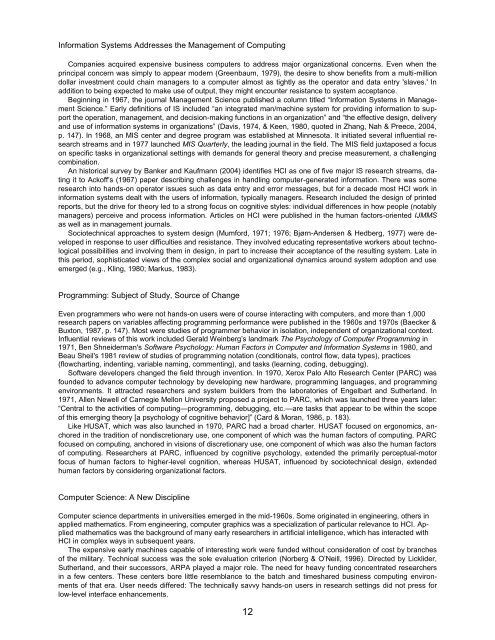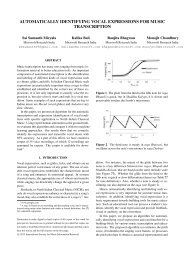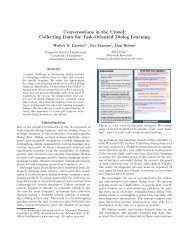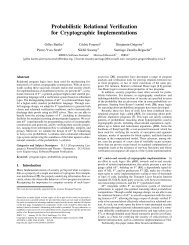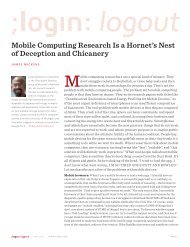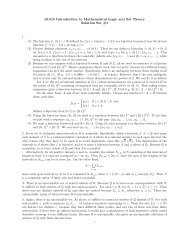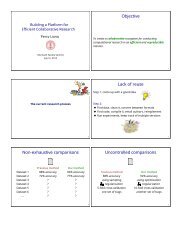A Moving Target—The Evolution of Human-Computer Interaction
A Moving Target—The Evolution of Human-Computer Interaction
A Moving Target—The Evolution of Human-Computer Interaction
Create successful ePaper yourself
Turn your PDF publications into a flip-book with our unique Google optimized e-Paper software.
Information Systems Addresses the Management <strong>of</strong> Computing<br />
Companies acquired expensive business computers to address major organizational concerns. Even when the<br />
principal concern was simply to appear modern (Greenbaum, 1979), the desire to show benefits from a multi-million<br />
dollar investment could chain managers to a computer almost as tightly as the operator and data entry 'slaves.' In<br />
addition to being expected to make use <strong>of</strong> output, they might encounter resistance to system acceptance.<br />
Beginning in 1967, the journal Management Science published a column titled “Information Systems in Management<br />
Science.” Early definitions <strong>of</strong> IS included “an integrated man/machine system for providing information to support<br />
the operation, management, and decision-making functions in an organization” and “the effective design, delivery<br />
and use <strong>of</strong> information systems in organizations” (Davis, 1974, & Keen, 1980, quoted in Zhang, Nah & Preece, 2004,<br />
p. 147). In 1968, an MIS center and degree program was established at Minnesota. It initiated several influential research<br />
streams and in 1977 launched MIS Quarterly, the leading journal in the field. The MIS field juxtaposed a focus<br />
on specific tasks in organizational settings with demands for general theory and precise measurement, a challenging<br />
combination.<br />
An historical survey by Banker and Kaufmann (2004) identifies HCI as one <strong>of</strong> five major IS research streams, dating<br />
it to Ack<strong>of</strong>f’s (1967) paper describing challenges in handling computer-generated information. There was some<br />
research into hands-on operator issues such as data entry and error messages, but for a decade most HCI work in<br />
information systems dealt with the users <strong>of</strong> information, typically managers. Research included the design <strong>of</strong> printed<br />
reports, but the drive for theory led to a strong focus on cognitive styles: individual differences in how people (notably<br />
managers) perceive and process information. Articles on HCI were published in the human factors-oriented IJMMS<br />
as well as in management journals.<br />
Sociotechnical approaches to system design (Mumford, 1971; 1976; Bjørn-Andersen & Hedberg, 1977) were developed<br />
in response to user difficulties and resistance. They involved educating representative workers about technological<br />
possibilities and involving them in design, in part to increase their acceptance <strong>of</strong> the resulting system. Late in<br />
this period, sophisticated views <strong>of</strong> the complex social and organizational dynamics around system adoption and use<br />
emerged (e.g., Kling, 1980; Markus, 1983).<br />
Programming: Subject <strong>of</strong> Study, Source <strong>of</strong> Change<br />
Even programmers who were not hands-on users were <strong>of</strong> course interacting with computers, and more than 1,000<br />
research papers on variables affecting programming performance were published in the 1960s and 1970s (Baecker &<br />
Buxton, 1987, p. 147). Most were studies <strong>of</strong> programmer behavior in isolation, independent <strong>of</strong> organizational context.<br />
Influential reviews <strong>of</strong> this work included Gerald Weinberg’s landmark The Psychology <strong>of</strong> <strong>Computer</strong> Programming in<br />
1971, Ben Shneiderman's S<strong>of</strong>tware Psychology: <strong>Human</strong> Factors in <strong>Computer</strong> and Information Systems in 1980, and<br />
Beau Sheil's 1981 review <strong>of</strong> studies <strong>of</strong> programming notation (conditionals, control flow, data types), practices<br />
(flowcharting, indenting, variable naming, commenting), and tasks (learning, coding, debugging).<br />
S<strong>of</strong>tware developers changed the field through invention. In 1970, Xerox Palo Alto Research Center (PARC) was<br />
founded to advance computer technology by developing new hardware, programming languages, and programming<br />
environments. It attracted researchers and system builders from the laboratories <strong>of</strong> Engelbart and Sutherland. In<br />
1971, Allen Newell <strong>of</strong> Carnegie Mellon University proposed a project to PARC, which was launched three years later:<br />
“Central to the activities <strong>of</strong> computing—programming, debugging, etc.—are tasks that appear to be within the scope<br />
<strong>of</strong> this emerging theory [a psychology <strong>of</strong> cognitive behavior]” (Card & Moran, 1986, p. 183).<br />
Like HUSAT, which was also launched in 1970, PARC had a broad charter. HUSAT focused on ergonomics, anchored<br />
in the tradition <strong>of</strong> nondiscretionary use, one component <strong>of</strong> which was the human factors <strong>of</strong> computing. PARC<br />
focused on computing, anchored in visions <strong>of</strong> discretionary use, one component <strong>of</strong> which was also the human factors<br />
<strong>of</strong> computing. Researchers at PARC, influenced by cognitive psychology, extended the primarily perceptual-motor<br />
focus <strong>of</strong> human factors to higher-level cognition, whereas HUSAT, influenced by sociotechnical design, extended<br />
human factors by considering organizational factors.<br />
<strong>Computer</strong> Science: A New Discipline<br />
<strong>Computer</strong> science departments in universities emerged in the mid-1960s. Some originated in engineering, others in<br />
applied mathematics. From engineering, computer graphics was a specialization <strong>of</strong> particular relevance to HCI. Applied<br />
mathematics was the background <strong>of</strong> many early researchers in artificial intelligence, which has interacted with<br />
HCI in complex ways in subsequent years.<br />
The expensive early machines capable <strong>of</strong> interesting work were funded without consideration <strong>of</strong> cost by branches<br />
<strong>of</strong> the military. Technical success was the sole evaluation criterion (Norberg & O’Neill, 1996). Directed by Licklider,<br />
Sutherland, and their successors, ARPA played a major role. The need for heavy funding concentrated researchers<br />
in a few centers. These centers bore little resemblance to the batch and timeshared business computing environments<br />
<strong>of</strong> that era. User needs differed: The technically savvy hands-on users in research settings did not press for<br />
low-level interface enhancements.<br />
12


